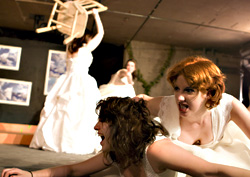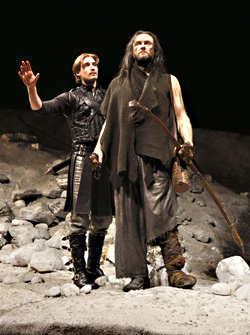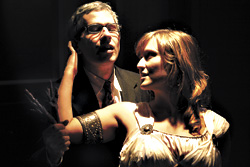One night in the 1950s, Malcolm Cowley, the Stanford writing teacher who made William Faulkner, Jack Kerouac, and Ken Kesey famous, declined his student Kesey’s offer of a cup of green hallucinogenic Kool-Aid from a punch bowl billowing sinister clouds of dry-ice smoke. “It looks like the sort of punch that Satan would serve,” observed Cowley, who drank Kesey’s grandma’s Arkansas bootleg whiskey instead. In Robert Stone’s novel Dog Soldiers, the character based on Kesey is “Doctor Dope,” a self-sacrificing guru whose followers think he is God.
So what was Kesey, devil or deity? Conservatives decry his flabbergastingly irresponsible acid evangelism; when he died two years ago, eulogists stressed his saintly side. Now that his celebrated bus, Further, has long since literally conveyed him to the grave, it’s a better time to put Kesey to the moral acid test: He belongs to the ages, not his mourners, and this winter marks his literary last stand.
Two new books are almost certainly the final volumes to whip up the patchouli twister of his prose: Kesey’s Jail Journal, composed during his six-month 1967 pot-bust hitch in San Mateo County Jail, and Spit in the Ocean: All About Kesey, distinguished writer and old Kesey chum Ed McClanahan’s collection of the Prankster Pope’s own witty encyclicals, touching letters to friends, and rare interviews and essays from 1968 to 2001, plus reminiscences from Tom Wolfe, Hunter Thompson, Gus Van Sant, Bill Walton, Paul Krassner, Robert Stone, and Larry McMurtry.
When Kesey forsook literature in 1964 to become a man of lettersLSDdid he blow it? Or did he ignite a refining fire that still burns bright at the heart of every rave in America? Did drugs make him, or undo him? Was Cowley right to believe it would’ve been better had Kesey just said no to the Bus, shackled himself to his typewriter, batted out more books, and steered clear of public acts of shameless shaman magic?
THE HUMILIATION OF CREATION
“Being shackled to anything, even a typewriter, just wasn’t in Ken’s nature,” McClanahan opines. “The stage and magic, on the other hand, were very much in his nature.”
The Jail Journal proves McClanahan’s point. Even in actual shackles, Kesey defiantly kept conducting symphonies of trouble with his magic wand. Originally titled Cut the Motherfuckers Loose, the book portrays one cut-loose motherfucker. The psychedelectable Day-Glo pen drawings of convicts and fantasias, idylls and race riots, showcase his little-known visual imagination, a style that recalls by turns Peter Max, William Blake, Fillmore rock posters’ unruly wraparound lettering, the transgressive collages of Kenneth Halliwell and Joe Orton, and Steve Ditko’s Dr. Strange.

Kesey attempted the ultimate fusion of art and action.
(Duke Downey / Keseys jail journal) |
The very possession of pens and paper was forbidden Keseyhe was sure to use them to stab back at authority. So he was unwise to scribble this book on the sly and smuggle it out as contraband concealed in porn mags whose pages he stuck together to discourage guards from inspecting them. He let visitors prankishly slip him “four STP tabs couple of psilocybin pills and five good old Owsley purples!” Under the guards’ noses, he took a mind-blown skinny-dip in the prison pool”without taking the mandatory shower.” Crazily, he stashed this diary of crimes in progress inside a hollowed-out book in a fellow inmate’s cell. One day a deputy asked him point-blank if he was loaded. Pin-pupilled on opium, Kesey said, “Allow me to make one thing clear before we continue our conversation . . . I’ll lie to you.”
The Jail Journal may not be strictly factual, but it’s an authentically exuberant, sardonic slice of the Summer of Love behind bars; Spit in the Ocean is more poignant and retrospective, a fond, funerary Festschrift of Stony Age scholarship. Both show that Kesey wasn’t about partying in the modern, mindless sense. He believed his kind of questing partying might save the world, one soul at a timeor hey! Maybe everyone at once, if he could only get his magic act together. Like the Acid Test, the Journal is an attempt to fuse all sensations and artistic means into one ecstatic new form of expression in which (as the Kesey character says in Dog Soldiers) “there was absolutely no difference between thought and action.”
In the Spit book, Robert Stone (who is penning his own memoir about “Doctor Dope”) says that Kesey was out to transcend the whole business of making books: “I think he believed that he could somehow invent a spiritual technology, somewhere between Silva mind control and the transistor, that would spare all the humiliating labor that went into the creating of art.”

CANNIBALIZED BY THE MERRY PRANKSTER
Like virtually every literary experiment, Kesey’s was largely a failure. The Journal succeeds in seizing a moment or three, but it’s utterly inferior to his first forbidden text, One Flew Over the Cuckoo’s Nest, done during his 1950s stint working at the VA hospital near Stanford. As he notes in the Journal, the jail scene was very like the VA hospital; he composed under similar circumstances, sketching patients on his employer’s time, “jumping every time I heard a lock rattle and stuffing the pages out of sight in the wastepaper basket.”
Despite being frightened by the military nurse who ran the place, he defied authority and inevitably got fired. He transmogrified her into Big Nurse, the personification of tyranny, and the VA patients into the novel’s vivid characters (see sidebar, p. 28).
By trying to fuse thought and action and bypass traditional art, he accomplishes nothing comparable in the Journal. Cuckoo attained greatness thanks to a lucky combination of inspiration and perspiration visions and many, many revisions paring the experience down to a pure parable as simple as a pop tune or a nursery rhyme. In the Journal, and too often after, Kesey tried to get by on visions alone. Though he wrote some lovely pieces later in lifehis elegy for John Lennon, his tribute to the Pendleton Roundup with co-writer Ken Babbsthe sustained masterpieces that sprang from his LSD days were written by others: Tom Wolfe’s The Electric Kool-Aid Acid Test and Stone’s National Book Award winner Dog Soldiers, which is in part a debate about Kesey’s legacy. In Stone’s book, the Kesey character’s apostate apostle calls his ambitious acid crusade “a flash”the slang term for an LSD trip, which he considers a meaningless cultural flash in the pan. “It was our responsibility,” retorts the Kesey character. “We should’ve stayed with that flash forever.”
Why didn’t Kesey nab that award with his own work? He stayed with that flash foreverlived the high life. “He let the Merry Prankster persona swallow everything else, let it take over and cannibalize his role as a writer,” says David O. Weddle, who covered Kesey for Rolling Stone. “His life is a cautionary, perhaps even tragic, tale of the cost of celebrity and catastrophe of success for American artists. But in classic tragedy, the fall from grace throws into relief the magnificence of the hero’s achievements.” Kesey might argue that taking the plunge was his achievement. “Ken had a little joke,” writes Stone, “a little jingle on himself. He said, ‘Of offering more than what I can deliver, I have a bad habit, it’s true./But I have to offer more than what I can deliver, to be able to deliver what I do.'”
Kesey had bad drug habits, but they were complicatedly and not entirely badin some ways inspiring his creativity, but ultimately stifling it. He began as about the most abstemious major American writer this side of Pearl S. Buck. “He drank on his wedding night when he was a sophomore in college,” says Kesey scholar and friend Bennett Huffman, “and then he hadn’t had a drink [until] he moved to California [as a grad student].”
Eight peyote buttons gave Kesey the skeleton key to Cuckoo. The novel hadn’t been jelling when written in the third person, but that fateful cacti encounter supplied him with the hallucinatory opening-scene reverie of the novel’s half-mad first-person narrator. Cowley convinced Kesey to trim back the overwritten passages, helping to save him from the “first thought, best thought” folly that ruined Kerouac, whom Cowley thought “was corrupted by the notion that every word that fell from his lips was more or less sacred.” Kesey was always more skeptical and self-critical than peers like Allen Ginsberg and the jaunty fraud and admanlike hack Tim Leary. At least Kesey never OD’d on ego.
He wrote his second masterpiece under the overwhelming influence of Faulkner and amphetamines. “Ken was taking speed for 30 hours a block when he wrote Notion,” says Huffman. “He’d stay up for a day and a half just doing nothing but writing nonstop and then sleep for 12 hours and then do it again.” Just as Absalom, Absalom! is both powered and muddled by Faulkner’s end-stage alcoholism, Sometimes a Great Notion shrieks and grinds with speedy confusion. When Kesey writes, “Come look: the hysterical crashing of the Wakonda Agua River,” the hysterical river in question is his own stream of consciousness. Then came the Bus and the Acid Tests, which swept away his concentration with a hysteria theretofore unprecedented.
Kesey complained in later years that getting older deprived him of the mental powers to write another book as complex as Notion. “He always attributed it to aging, but that wasn’t it, because a lot of people write great stuff late in life,” says Jeff Forester, a co-author of Caverns, the 1990 novel Kesey composed with his University of Oregon writing students, and a forthcoming memoir of that experience, Writing Under the Influence. “It was a lifestyle thing. A novel is such a long, complicated thing that you can’t smoke pot and keep it all sitting in your head.” On speed, writing Notion, says Huffman, “When Kesey woke up 12 hours later he could remember the work that he’d done before, so he could carry on, where if you’re writing on pot, you can’t remember.”

MOUNTING AN INSURRECTION
“You wished that he would get serious,” says Huffman. “We knew that if he could just, um, break a leg or something, throw his back out, something that could keep him indoors alone at his desk, he would write another great novel, but he never broke his leg. He had a stroke in ’97, and by ’99 he’s touring with the Bus in Great Britain. Back at the same old Kesey moving carnival show rather than sitting down and writing the next serious novel.”
Forester says writing a novel with Kesey was serious fun, anyhow. “I mean, the class was a party. Being around Kesey was a constant party.” The first day of class, Kesey assigned Forester to roll joints for the seminar; one student sparked up and passed out. “Fell to the groundout cold. One student says, ‘Omigosh, is he OK? We should call someone!’ Ken just stepped over the body and handed me the joint and just kept talking. Ken said, ‘Aw, he’ll be OK.'” A couple of minutes later, he was. “The first class, you pass outhow cool was that?” says Forester.
The Caverns pot party both was and wasn’t cool for Kesey’s career. It generated scant literary buzz, but did get him back in the habit of sitting down and writing, twice a week. Sailor Song and the other autumnal books that Caverns freed him up to write can’t match his first two, but they have their fans. “There are those fleeting moments of startling imagery, or well-observed events that gleam like the shards of a once-great but now shattered talent,” says Weddle. “Unfortunately, too much of the book is dominated by that glib, self-consciously clever, alliteration-happy voice of Kesey’s later years. He was aware of the problem.”
Literary vice wasn’t his main problem. Ominously, Caverns made Kesey revert to old notions of composing. “At the end when we were kinda getting to crunch time,” says Forester, “it seemed like Ken was in the office 24/7, and there was this little vial that was stashed in a corner cabinet that had some, I think it was like grain alcohol or something that had some speed in it. Just a couple of drops of that in your drink or your coffee, and it was days, you know, and we just kinda churned through this thing and it really affected his health. By the end of the class he ended up in the Mayo Clinic.”
In the end, acid had nothing to do with Kesey’s fate. His liver failed, thanks to cancer following hepatitis C, which also killed Kesey’s pals Ginsberg and Steve “Zonker” Lambrecht, who inspired Doonesbury‘s Zonker. Most people get hepatitis C from promiscuous sex (not Kesey’s thing) or needles. Kesey’s Jail Journal talks about his injections of speed. But his ultimate enemy was alcohol. “That’s the horrible truth, that Ken drank himself to death,” says Forester. “Even after he found out he had hepatitis C, he kept drinking. He had diabetes but he kept drinking, and he just wasn’t gonna stop. Weddle once asked him, ‘Did drugs ruin you?’ He said, ‘No, I know what’s done me harm, and it’s not LSD or marijuana, it’s too many vodka martinis.’ So he was self-aware, unlike most addicts.” Like Carrie Fisher, he sought mind expansion and pain reduction only to wind up with pain expansion and mind reduction. Weddle, the biographer of Sam Peckinpah, compares Kesey to that cinematic genius who also self-destructed on drugs and booze. “At his funeral, Peckinpah’s close friend Robert Culp said, ‘Let’s not obsess over all the movies he never got to make. Let’s instead rejoice over the fact that there is a Wild Bunch at all. That he managed to get it made is a miracle, given the odds against it.'” McClanahan insists that Kesey smuggled plenty of miracles past his demons. “I mean, 11 books, including two indisputably great ones, ain’t badfor the record, I think the jailbook ranks a close third.”
In the end, it’s crucial to consider Kesey’s work in terms of its influence on people, because he was essentially social, a performer who could not long endure the solitary writer’s life. No doubt the reality-scrambling potations he touted did harm to some, but his imagination could also rescramble reality for the better. One Oregon mental patient reportedly lost his Billy Bibbit-like crippling stutter as a result of the inspirational effect of working on the Cuckoo’s Nest film. Paul McCartney says Magical Mystery Tour was inspired by Kesey. His entire life can be seen as the most influential bus ride since Rosa Parks’.
In Spit in the Ocean, Krassner relates how he and Kesey very nearly died by falling in the ocean in 1971: They climbed into a tunnel carved into a cliff during World War II (so lookouts could scan the ocean for enemy ships), found a “meek little mouse” in the tunnel, and blew hashish smoke into its face until the mouse reared up and squeaked in protest. “This display of mouse assertiveness startled us, and we almost fell off the cliff.” What a perfect death! Better than John Lennon’s near death during Sgt. Pepper, when he took a handful of aspirin that turned out to be acid and came within inches of walking off Abbey Road’s rooftop, exclaiming, “Look at the stars!” Kesey looked at the people instead; he inhaled in order to exhale insurrectionary orders, rallying the suburban mice of the Earth to rise up and roar in rebellion.








